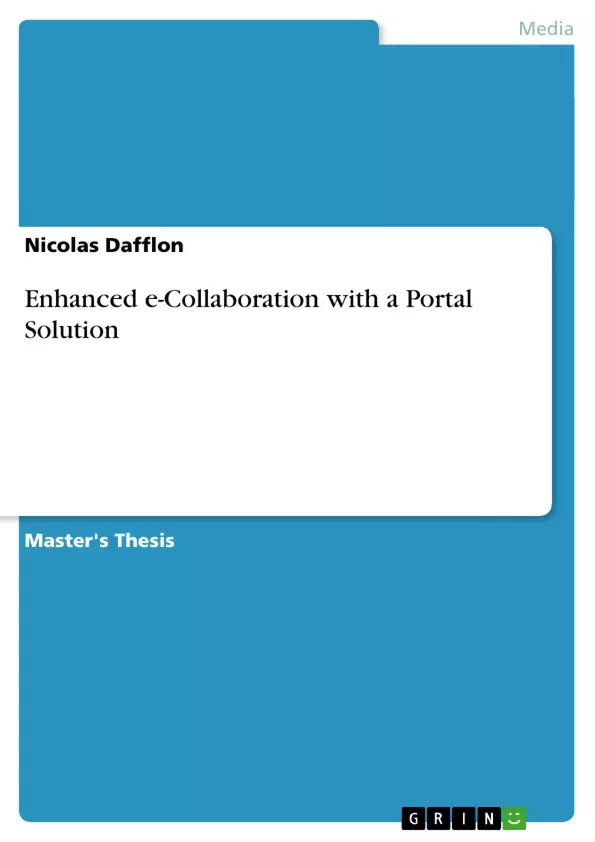The collaboration between people has taken another dimension. Current information management systems allow users to save time, to work efficiently in different time zones and at different locations worldwide. E-collaboration strongly contributes to reducing costs and to enhancing coordination and cooperation. The community further needs to collaborate because they are rarely able to solve problems on their own. Projects need to be coordinated so that deadlines can be met. Companies’ branches are decentralized in order to reduce production-costs and to operate on a global market. Communication within a group is crucial to success. A project only succeeds if people exchange a maximum amount of information. Managers should permanently be informed so that they can decide at the right time or react if a project is taking a wrong turn. This flow of information has to be bi-directional: employees ought to be informed in a timely manner on management decisions. Information can be transmitted through different channels. Additionally, people ought to work with standardized documents. A common naming convention helps to find information which is shared on a platform. Systems should be user-friendly and reactive. Communication by E-mail demands clear rules. Documents and templates have to be available to everyone and need regular updating.
It is unthinkable to plan an international exercise or a big project without the help of network components and telecommunication systems. Communication and collaboration become difficult if people are geographically separated. Collaboration difficulties are influenced by different cultures, language and work standards. E-mail communication must be clear and brief. E-mailing leads to debates. Some people get frustrated by e-mailing as a means of communication if used to communicate not only information, but is used to task people. Other people feel bothered by the style of email. For e-mailing to be efficient, messages should be answered within 24 hours. Certain people do not like to feel dominated by this technology. Chapter 3 focuses on the basic concepts of e-collaboration and discusses related problems.
The result of this research and the experience during the exercise could be summarized in form of a guideline helping an integration of e-collaboration system. This guideline contains at first some questions which should be answered before beginning the project.
Inhaltsverzeichnis (Table of Contents)
- Executive Summary
- Aims of this thesis
- Result of the case study
- Acknowledgements
Zielsetzung und Themenschwerpunkte (Objectives and Key Themes)
This thesis aims to identify, assess, and discuss challenges related to e-collaboration systems and their implementation, proposing recommendations for optimal integration of e-tools. The portal configuration and integration within the VIKING exercise serves as a case study, analyzing the technical results and their implications. The assessment encompasses communication systems, IT infrastructure, processes, and structures concerning training and user acceptance, leading to a guideline for future e-collaboration system integrations.
- Challenges and opportunities of e-collaboration systems
- Optimal integration of e-tools for enhanced collaboration
- Analysis of VIKING 08 exercise as a case study
- Assessment of communication systems, IT infrastructure, processes, and structures
- Development of a guideline for future e-collaboration system integrations
Zusammenfassung der Kapitel (Chapter Summaries)
The executive summary provides an overview of the thesis, highlighting the significance of e-collaboration in modern communication and outlining the objectives and methodology employed. The aims of the thesis further elaborate on the specific goals of the research, emphasizing the importance of optimal e-tool integration and the use of the VIKING 08 exercise as a case study. The result of the case study summarizes the key findings from the VIKING 08 exercise, focusing on the challenges and opportunities of e-collaboration in a real-world scenario. The chapter highlights the importance of user training, system stability, and communication infrastructure for effective e-collaboration.
Schlüsselwörter (Keywords)
The main keywords and focus topics of this thesis include: e-collaboration, portal solutions, communication systems, IT infrastructure, user acceptance, training, VIKING 08 exercise, case study, and guidelines for future integrations.
- Citar trabajo
- Nicolas Dafflon (Autor), 2009, Enhanced e-Collaboration with a Portal Solution, Múnich, GRIN Verlag, https://www.grin.com/document/140048



